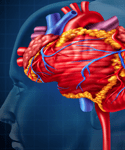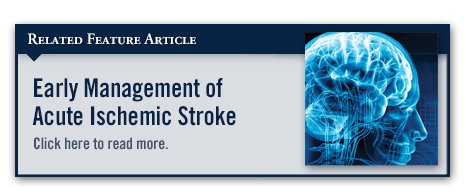Clinical outcomes after stroke can be devastating and include high risks of mortality and severe debilitation. In a study published in the American Journal of Cardiology, my colleagues and I sought to develop a clinical risk prediction model that would allow physicians to identify patients with acute coronary syndrome (ACS) who are at a higher risk of developing in-hospital stroke. We wanted to identify independent risk factors for developing a stroke in the acute time period of an ACS. The final model was created based on data from 63,118 patients with a total of 217 ischemic strokes.
Testing a New Model
Using a multivariable analysis, eight baseline and presenting clinical characteristics were independently associated with the occurrence of ischemic stroke:
1. Older age.
2. Atrial fibrillation or flutter on index electrocardiogram.
3. Systolic blood pressure ≥160 mm Hg.
4. Positive initial cardiac biomarkers.
5. No previous or current smoking.
6. ST segment change.
7. Killip class II to IV.
8. Lower body weight.
The risk prediction model for the primary endpoint of ischemic stroke within 14 days of hospitalization was developed by converting final model estimates to points. For example, each 10-kg decrease in weight, starting with 210 kg to 219 kg, was assigned 1 point. Atrial fibrillation or flutter was assigned 4 points. Points for each of any of the eight patient factors were summed to obtain a total patient risk score. Patients with risk scores of 21 to 27 had a 14-day stroke risk of about 0.4%. This risk increased to more than 1.0% when scores rose above 30 points and to 1.0% or 2.0% in those with a score of 32 to 37.
Model-predicted stroke rates had a strong correlation with actual observed rates. Age was a strong predictor of stroke risk; we saw a 20% higher risk for every 10 years of age. Our findings also suggest that cardioembolism may be an important predictive mechanism of stroke. When CABG and PCI were added into the model of eight patient characteristics, both emerged as independent risk factors for stroke in this population. Those who underwent CABG were at greatest risk for stroke.
From Concept to Practice
Physicians who care for patients presenting within the full spectrum of ACS can use the risk predictor used in our study to determine whether patients are at low or high risk for acute stroke. With further research, the hope is that our model will be validated by other analyses and that the risk predictor will be used in larger settings in an attempt to alleviate the burden of stroke in ACS patients. Our model may also prove beneficial in helping clinicians decide whether to add anticoagulants with vitamin K antagonists to dual antiplatelet therapy to further improve outcomes.




 admin
admin